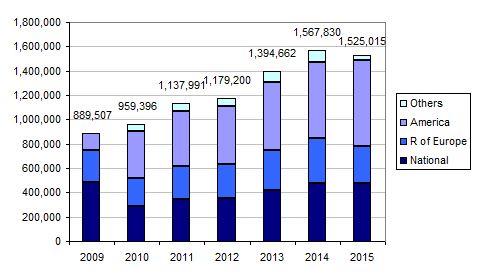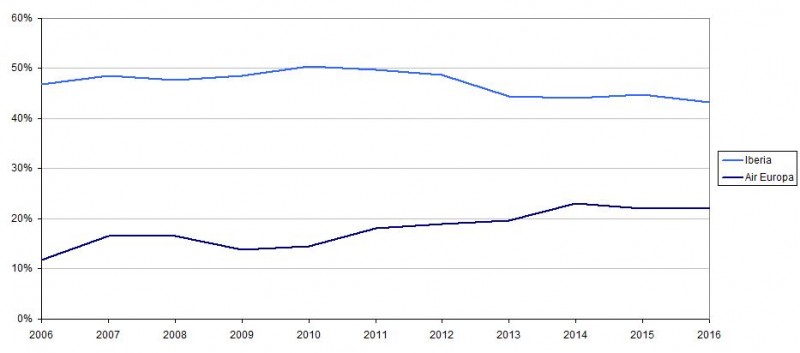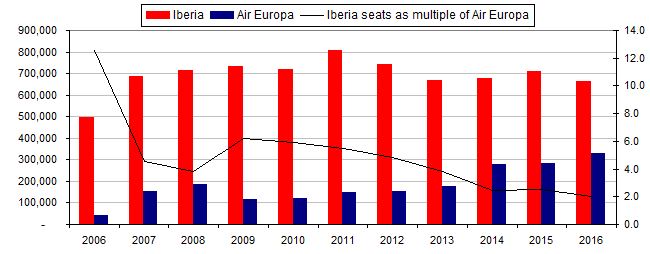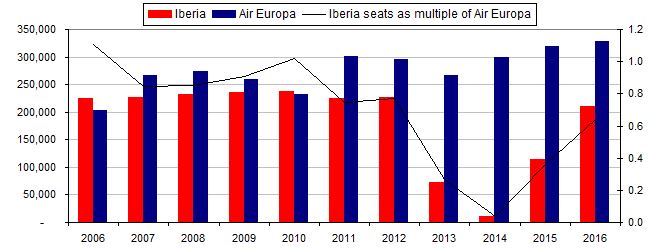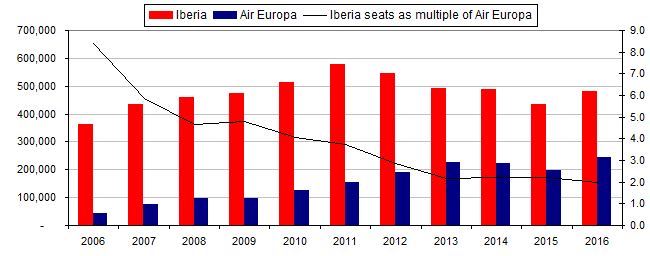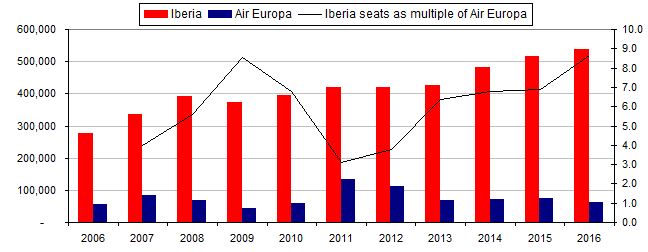Air Europa Part 1: Latin America drives growth. Iberia and new entrants provide challenges
Air Europa's 28-Jun-2016 launch of a new daily Madrid-Bogota service returns the spotlight to its Latin American network. This is the airline's most important route region both by capacity and by revenue, and it remains at the heart of its future plans. Air Europa has 13 Latin American destinations - compared with Iberia's 19 - and has been linked with plans for several more.
By seat capacity on Spain-Latin America Air Europa is half as big as Iberia but its share has increased by 10ppts over the past decade, while Iberia's has fallen. Iberia was four times Air Europa's size in this market in 2006. Nevertheless, a re-energised Iberia remains a formidable competitor and there is a small, but growing, band of new entrants.
Air Europa's parent company Globalia is reportedly considering an IPO, having previously been in talks with HNA Group about a possible investment by the Chinese conglomerate. Air Europa is likely to defer plans for the launch of routes to China while it concentrates on Latin America.
Part 2 of this analysis will look at Globalia's financial track record. It will also examine Air Europa's unit revenues, fleet and unit cost positioning.
International routes 78% of Air Europa ASKs and continuing to drive growth
According to the Globalia 2015 annual report Air Europa increased its scheduled ASKs by 9% in FY2015, continuing its robust growth, albeit at a more modest pace than the 17% increase of FY2014. Note that the group's financial year end was October up to and including 2014, while FY2015 coincides with the calendar year.
Air Europa's passenger load factor gained 0.2 ppts to 84.0%, although this did not fully recover the previous year's decline, and load factor remained slightly below its 2013 peak of 84.5%. This load factor puts it comfortably ahead of the global industry average of 80% and 5.3ppts above its own FY2011 level.
The capacity increase in FY2015 was driven more by international routes, where ASK growth reached 10%. Total domestic capacity grew by 4%, driven by an 11% increase on mainland Spanish routes and 20% growth on routes to the Balearic Islands, partially offset by a cut of 1% on routes to the Canary Islands (where Air Europa's capacity in ASKs is equal to its mainland and Balearic capacity combined).
International routes increased their share of Air Europa's total ASKs to 78% in FY2015, from 77% in the previous year and 61% in FY2009.
Air Europa: development of scheduled ASK ('000, left hand axis) by region and total scheduled load factor (%, right hand axis), FY2009 to FY2015*
Latin America dominates Air Europa's international ASKs
The Globalia annual report does not break down international ASKs by region, but this segment is dominated by Latin America.
According to OAG data for the week of 4-Jul-2016, Latin America accounts for two thirds (67%) of Air Europa's international ASKs, Europe accounts for 19%, and North America for 14% (it also has a very small amount of capacity in the Middle East and Central/Western Africa).
Even in North America, two of Air Europa's destinations (Miami and San Juan, Puerto Rico) have strong Latin links (its third destination is New York).
Air Europa revenue fell in 2015…
Full details of Air Europa's accounts are not separately disclosed, but Globalia's annual report shows the group's revenue by business segment. The Air Division of the Globalia group - which consists of Air Europa - generated revenue of EUR1.5 billion in FY2015 (calendar year), which was a 3% reduction on the figure reported for the previous financial year (year to Oct-2014) in spite of capacity growth.
This was the first drop in revenue for Air Europa since FY2009, after which revenue growth was driven by international routes until FY2014.
Air Europa: development of revenues (EUR '000), FY2009 to FY2015*
Revenue on 'National' routes (i.e. domestic) was flat in FY2015. Although National revenue grew steadily from FY2010 to FY2015, it remained 2% below its FY2009 level. This segment accounted for 31% of total revenue in FY2015, compared with 54% in FY2009.
Air Europa's total international revenue increased by 170% from FY2009 to FY2014, taking its share of Air Europa's total from 46% to 70% before dropping by 4% in FY2015, when its share dipped to 69%.
Within international revenue the contribution from the rest of Europe dropped by 16% in FY2015, after growing consistently from FY2010 to FY2014. This was Air Europa's biggest fall in revenue from any of its main route regions in FY2015 and likely reflects the strength of competition - particularly from LCCs. The Jan-2016 launch of Air Europa Express may help it to compete in short haul markets, although its initial focus on domestic routes and Embraer 195/ATR72 aircraft limits its scope.
Revenue from this segment was 19% higher in FY2015 than in FY2009, but its 20% share of the total was below the 29% share that it had in FY2009. The rest of Europe segment is Air Europa's smallest major region by revenue, but still of strategic importance in supplying feed to the long haul network.
However, revenue continued to grow on the America network
Revenue on the 'America' network (most of this is Latin America) bucked the falling trend in FY2015, growing by 13%. America revenue was almost five times its FY2009 level in FY2015, taking its share of Air Europa's total revenue from 16% to 46% over the same period. From FY2009 to FY2015, America was responsible for incremental revenue of EUR564 million for Air Europa, out of a total increase of EUR636 million.
Air Europa continues to place America at the heart of its strategic thinking. Its target is reportedly to generate over 50% of its revenues from the Americas continent (El Economista, 31-May-2016).
Air Europa is number two to Iberia in its most important region - Latin America
As noted above, Latin America is Air Europa's most important region - it accounts for two thirds of its international ASKs. Moreover, the America region is Air Europa's biggest region for revenue, accounting for 46% of the total. This includes North America, but Latin America accounts for 80% of Air Europa's ASKs to the Americas. This gives a good indication of Latin America's importance to the revenue generated in the Americas; and its importance to Air Europa overall.
According to data from OAG Schedules Analyser, Air Europa is number two to market leader Iberia by seats on routes from Spain to Latin America. Air Europa's share of seats is 22% this year, just over half of Iberia's 43%. Note that this is based on the combined winter 2015/2016 and summer 2016 schedules.
The two Spanish airlines dominate this market, with the highest-ranked Latin American participant - the LATAM Group - taking only 11% of seats, followed by Avianca with 8% (based on OAG data for the 12 months to the end of summer 2016).
Airlines ranked by share of seats from Spain to Latin America: 2016*
|
Rank |
Airline |
Share of seats 2016* |
|---|---|---|
|
1 |
43% |
|
|
2 |
22% |
|
|
3 |
LATAM Group |
11% |
|
4 |
8% |
|
|
5 |
4% |
|
|
6 |
3% |
|
|
7 |
2% |
|
|
8 |
1% |
|
|
9 |
1% |
|
|
10 |
1% |
Air Europa's share of Spain-Latin America has largely held gains made during Iberia restructuring
Following its merger with British Airways to form IAG in 2011 Iberia's restructuring programme involved significant capacity cuts. It cut its seat numbers to Latin America by 5% in 2012 and 14% in 2013, maintaining this lower level of capacity in 2014. Since then Iberia has returned to growth - by 7% in each of 2015 and 2016.
See related reports:
However, Iberia's seat numbers in 2016 are still 7% below their 2011 peak. In 2011 its seat share in the Spain-Latin America market was 50% (a share that it first achieved in 2010), compared with 43% in 2016. In spite of Iberia's return to growth, its 2016 share is below its 2015 level of 45%, as other participants have grown faster.
The main beneficiary of Iberia's reduced market share since 2010 has been Air Europa, whose share of seats increased from 15% in 2010 to 22% this year. This is only slightly lowered from 23% in 2014 and is stable against 2015. The rapid growth of other competitors has had a lesser impact on Air Europa's share than on Iberia's.
Air Europa also cut its Spain-Latin America seat capacity by 2% in 2013, but grew strongly in 2014 (+14%). In 2015 it grew by less than 1%, but Air Europa's 2016 seat numbers are up by 11% year-on-year.
Note: as was the case for the 2016 market share ranking presented above, this analysis (and what follows) is based on 12 month periods to the end of the summer schedule in the year shown (i.e. the previous winter schedule plus summer schedule of year shown).
Air Europa and Iberia share of seats from Spain to Latin America: 2004-2016*
LATAM, Avianca: new entrants are growing their share of Spain-Latin America
The two leading Latin American airlines in the market to/from Spain, Avianca (a codeshaer partner of Air Europa) and LATAM Group (and its constituent airlines in the LAN and TAM groups prior to its formation) have both increased their seat share since 2010, while their combined operation remains smaller than Air Europa in this market. The next two Latin American airlines, Aerolineas Argentinas and Aeromexico (both are Air Europa codeshare partners), have modestly reduced their share.
In addition to market share gains by LATAM and Avianca, a number of new entrants have come onto the Spain-Latin America market in the past five years, according to data from OAG.
In order of 2016 seat numbers, these include: Evelop Airlines (entered in 2014); Wamos Air (2015); Boliviana de Aviacion (2013); Singapore Airlines (2011); FlexFlight (2011); and the most recent new entrant - Plus Ultra (entered in summer 2016). Although they are each small players, their aggregate share tops 6% and their aggregate capacity is up 20% year-on-year in 2016.
Spain to Latin America: market share of smaller airlines by seats, 2004-2016*
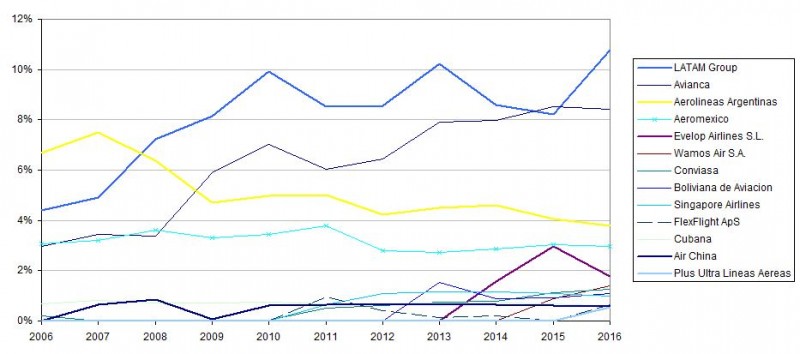
Iberia is twice Air Europa's size in Latin America, but was four times its size 10 years ago
Iberia is Air Europa's most important competitor on its most important regional network. According to data from OAG, ten years ago Iberia had four times as many seats on routes between Spain and Latin America as Air Europa now has.
In 2016 Iberia is 'only' twice as big as Air Europa in this market. This ratio fell dramatically during Iberia's restructuring but has stabilised since 2014, when CAPA last analysed the Latin America networks of the two airlines.
See related reports:
- Air Europa: Latin America remains key strength, but Iberia is re-awakening
- Iberia vs Air Europa in Latin America: two to tango, as Air Europa expands, Iberia contracts
Iberia and Air Europa total seats Spain to Latin America: 2003 to 2016*
Lower South America: Air Europa doubles capacity in five years as Iberia cuts again
Air Europa's biggest subregion of Latin America is now Lower South America, having overtaken Central America this year after a period of rapid growth. Air Europa is growing its seat capacity to Lower South America by 17% in 2016, when it will be more than twice its 2011 level (based on 12 month periods to the end of the summer season; source: OAG).
It is also the biggest subregion for Iberia, which is cutting seat numbers by 6% in 2016, and then its capacity will be 18% below its 2011 level. Iberia cut heavily in this market in 2012 and 2013, before growing once more in 2014 and 2015 (although more slowly than in other parts of Latin America).
In 2016 Iberia has dropped back to its 2013 capacity; in fact the ratio of Iberia's seats to Air Europa's seats in Lower South America is at its lowest ever level of 2.0 times (it was more than 12 times a decade ago).
Iberia and Air Europa total seats Spain to Lower South America: 2003 to 2016*
Caribbean: Iberia resurges strongly, but Air Europa is still bigger
In the Caribbean - the airline's second biggest Latin America subregion by seats - Air Europa is growing seat capacity by 3% in 2016, according to OAG data. Iberia all but abandoned this market during its restructuring, cutting seat numbers by 69% in 2013 and 85% in 2014, since when it has staged a dramatic re-entry. Iberia is growing by 84% to the Caribbean in 2016, when its seat numbers will be within 7% of their 2012 level.
In spite of Iberia's strong growth over the past two years, the Caribbean remains the only part of Latin America where it is smaller than Air Europa. Iberia has 36% fewer seats than its rival in 2016.
Iberia and Air Europa total seats Spain to Caribbean: 2003 to 2016*
Upper South America: Air Europa and Iberia both growing seat numbers again in 2016
In Upper South America, Air Europa's third biggest subregion, it is growing strongly in 2016 - by 25%, after two years of capacity cuts. Iberia is also growing at a double-digit rate (11%) in 2016, after cuts in each of the previous four years. This is the last region of Latin America in which Iberia has returned to growth following its restructuring.
Iberia has 2.0 times Air Europa's capacity to the region in 2016. This ratio has broadly stabilised since 2014, but it was 8.4 times in 2006.
Iberia and Air Europa total seats Spain to Upper South America: 2003 to 2016*
Central America: Iberia's subregion of greatest superiority vs Air Europa
Central America is Air Europa's smallest subregion, and is the only one where it is reducing seat capacity in 2016 (with a cut of 17%), while Iberia is growing by 4% in what is its second biggest subregion. Iberia now has 8.6 times Air Europa's seat capacity, and this is by far its most significant level of seat capacity superiority among the subregions of Latin America.
Iberia and Air Europa total seats Spain to Central America 2003 to 2016*
Latin American route totals: Air Europa 13; Iberia 19; with eight overlaps
Iberia still has twice as many seats as Air Europa to Latin America (based on combined capacity data for the winter 2015/2016 and summer 2016 schedules from OAG, as noted above).
However, the discrepancy in the number of Latin American destinations served from Madrid is less significant: Iberia has 19 and Air Europa has 13. By comparison with the Aug-2014 situation, before Iberia resumed growth and when CAPA last compared the two airlines in Latin America, Iberia has added five destinations (Cali and Medellín in a triangular route in Jun-2015, Havana in Jun-2015, Montevideo in late Aug-2015 and Santo Domingo in Sep-2014).
Air Europa has gained a net total of just one since Aug-2014, adding Asunción in Dec-2015 and Bogotá in summer 2016, but discontinuing La Romana in Sep-2014.
The added routes have brought the destination overlap between the two networks to eight cities in Latin America - Bogotá, Buenos Aires, Caracas, Havana, Lima, Montevideo, Santo Domingo and São Paulo. This is up from four in summer 2014 (and three in summer 2013).
Iberia is bigger than Air Europa by seats on five of the eight overlap routes, while Air Europa has the upper hand on three. Iberia's superiority is on Madrid to Bogotá (but Avianca is bigger than both on this route), Buenos Aires, Montevideo and São Paulo. Air Europa is bigger on Caracas, Lima and Santo Domingo.
Air Europa is reportedly planning a new Madrid-Cartagena service and a Madrid-Rio de Janeiro in competition with Iberia. Other Latin American destinations under consideration include Mexico City, Panama City, Guayaquil, Santiago (all currently served by Iberia) and Cordoba (via Asunción).
Iberia and Air Europa destinations in Latin America at 6-Aug-2014 and 10-Jul-2016
|
Airport |
Country |
Iberia 6-Aug-2014 |
Iberia 10-Jul-2016 |
Air Europa 6-Aug-2014 |
Air Europa 10-Jul-2016 |
|---|---|---|---|---|---|
|
Asunción |
|
|
|
x |
|
|
Bogotá El Dorado |
x |
x |
|
x |
|
|
x |
x |
x |
x |
||
|
|
x |
|
|
||
|
|
|
x |
x |
||
|
x |
x |
x |
x |
||
|
x |
x |
|
|
||
|
Guayaquil Jose Joaquin de Olmedo |
x |
x |
|
|
|
|
Havana Jose Marti |
|
x |
x |
x |
|
|
|
|
x |
|
||
|
Lima Jorge Chavez |
x |
x |
x |
x |
|
|
Medellín |
|
x |
|
|
|
|
x |
x |
|
|
||
|
Montevideo Carrasco |
|
x |
x |
x |
|
|
x |
x |
|
|
||
|
|
|
x |
x |
||
|
x |
x |
|
|
||
|
Rio de Janeiro Galeão |
x |
x |
|
|
|
|
Salvador Luis E Magalhaes |
|
|
x |
x |
|
|
x |
x |
|
|
||
|
x |
x |
|
|
||
|
|
|
x |
x |
||
|
Santiago |
x |
x |
|
|
|
|
Santo Domingo Las Americas |
|
x |
x |
x |
|
|
São Paulo Guarulhos |
x |
x |
x |
x |
|
|
Total number of destinations |
|
14 |
19 |
12 |
13 |
Air Europa has had market share success, but is feeling unit revenue pressure
Air Europa used the period of Iberia's contraction to increase its market share in its most important market, namely Spain-Latin America. It has held on to most of its market share gains since Iberia's return to growth in 2015, helped by its more value-oriented product.
However, new entrants are growing rapidly and Iberia's renewed competitiveness puts pressure on unit revenue, particularly on the overlapping Latin American routes that make up more than half of its total in the region.
Moreover, Spain-Europe is dominated by LCCs and Air Europa is a small player in a crowded market (it is ranked sixth by seats on Spain-Western Europe for the week of 4-Jul-2016, according to OAG), which poses challenges to its ability to feed its Latin America network.
Air Europa's FY2015 revenue decline, in spite of capacity growth, highlights the downward unit revenue pressure that it feels.
Part 2 of CAPA's analysis of Air Europa will review its parent company Globalia's financial track record and examine the airline's unit revenue development in recent years. It will also assess its fleet and attempt to estimate its unit cost positioning relative to other European airlines.

